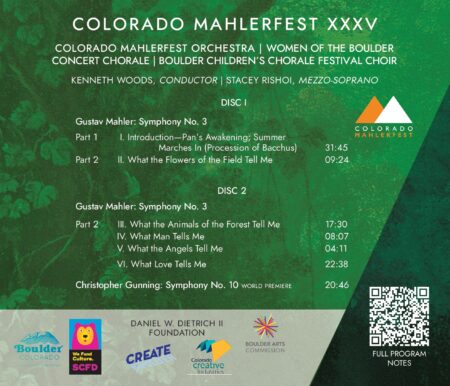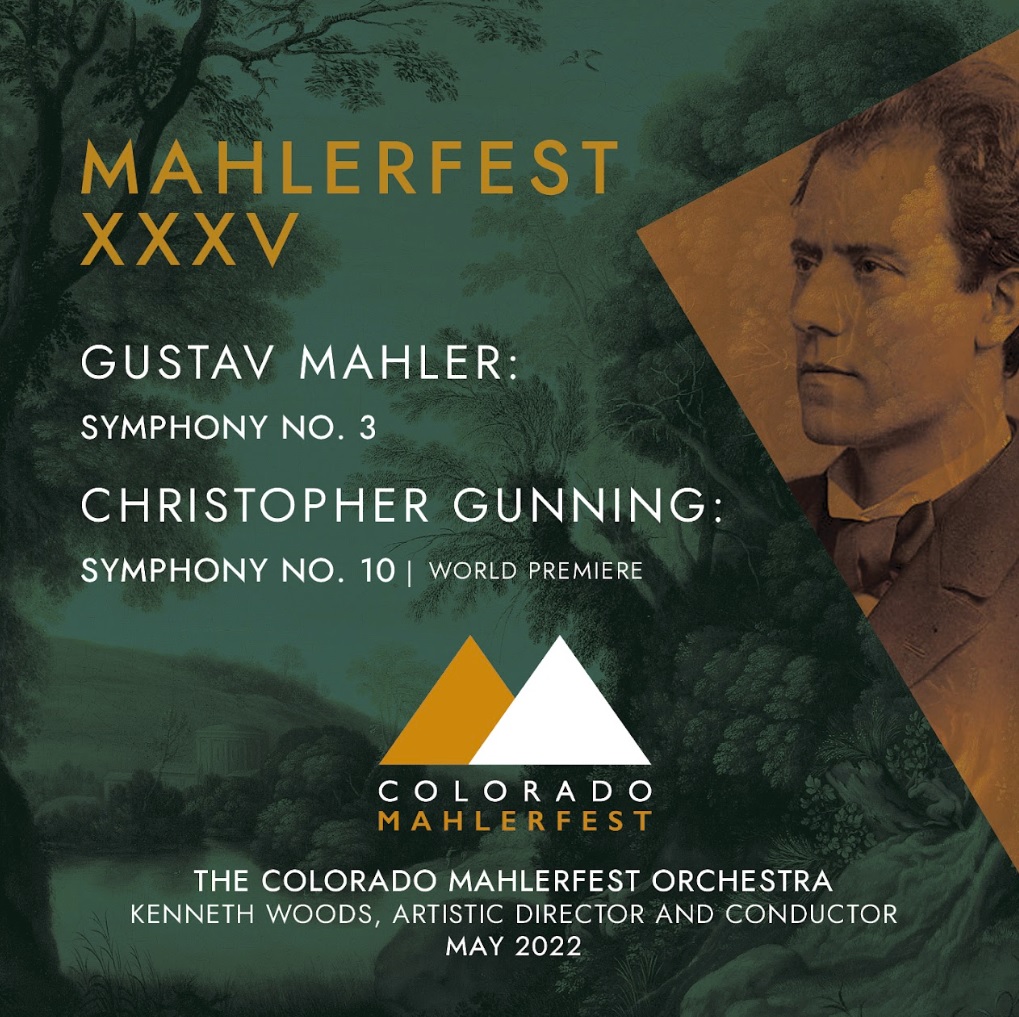Mahler Symphony No. 3 and Gunning Symphony No. 10
$20.00
This album is also available as a digital download from Bandcamp.
Description
COLORADO MAHLERFEST XXXV
- GUNNING Symphony No. 10 (2017) World Premiere
- MAHLER Symphony No. 3 (1896) U.S. premiere of Breitkopf and Härtel critical edition
Kenneth Woods, conductor
Stacey Rishoi, mezzo-soprano
Colorado MahlerFest Orchestra
Women of the Boulder Concert Chorale
Boulder Children’s Chorale Festival Choir
DISC 1
Gustav Mahler: Symphony No. 3
Part 1 I. Introduction—Pan’s Awakening; Summer Marches In (Procession of Bacchus) 31:45
Part 2 II. What the Flowers of the Field Tell Me 09:24
DISC 2
Gustav Mahler: Symphony No. 3 (continued)
Part 2 III. What the Animals of the Forest Tell Me 17:30
IV. What Man Tells Me 08:07
V. What the Angels Tell Me 04:11
VI. What Love Tells Me 22:38
Christopher Gunning: Symphony No. 10 WORLD PREMIERE 20:46
Recorded by Jonathan Galle
Editing and mastering by Tim Burton
RECORDED IN CONCERT MAY 22, 2022 | MACKY AUDITORIUM
BOULDER, COLORADO | © 2023 Colorado MahlerFest All Rights Reserved
Please note – for environmental reasons, this item is not shrink-wrapped.
This album is also available as a digital download from Bandcamp.

“Woods has assembled a genuinely top-notch orchestra, which this year included new concertmaster Zachary DePue, known for his leadership role in the Indianapolis Symphony Orchestra and the genre-crossing trio Time for Three. He is already familiar in Boulder through his many performances with the latter.
The performance of the Third under Woods was inspirational and revelatory, both in his musical and aesthetic choices. The tempi in the 35-minute first movement were often daring, but exhilarating. Principal trombone Lucas Borges was majestic in the long solo passages of the extended slow introduction. In the third movement depicting animals in the forest, trumpet player Richard Adams was mesmerizing in the offstage “posthorn” solos.
Mezzo-soprano Stacey Rishoi–who deeply moved the MahlerFest audience in 2018 with her performance in the orchestral song cycle Das Lied von der Erde–took up a smaller role here in the fourth and fifth movements, where Mahler turned to the human voice to express the entry of humanity, then the angels on the scene. Rishoi intoned the words of Friedrich Nietzsche with great sensitivity in the still, remarkably modern fourth movement.
In the fifth movement, Mahler asks for a women’s choir and a children’s choir for all of five minutes, but the symphony would be an entirely different entity without them. The Boulder Chorale, under the excellent leadership of Vicki Burrichter, and the affiliated Boulder Children’s Chorale made a remarkable impact. This was partly due to Woods’s brilliant decision to place the singers in the front rows of the house rather than at the back of the orchestra. He even directed the children to use their hands to amplify their voices once they get actual text to sing instead of the repeated “bimm bamm.”
Preceding the Third with another piece was bold, but fortunately Gunning’s 10th Symphony (which Woods recorded in 2019) is a tuneful and highly enjoyable piece of music, which proceeds logically and imaginatively through its twenty minutes after the distinctive viola opening. Gunning is known for his film scores, but he later moved to symphonic composition, producing thirteen works that have mostly been recorded but, until now, never performed before a live audience according to Woods.”
Kelly Dean Hansen – For the journal of the Gustav Mahler Society of New York





